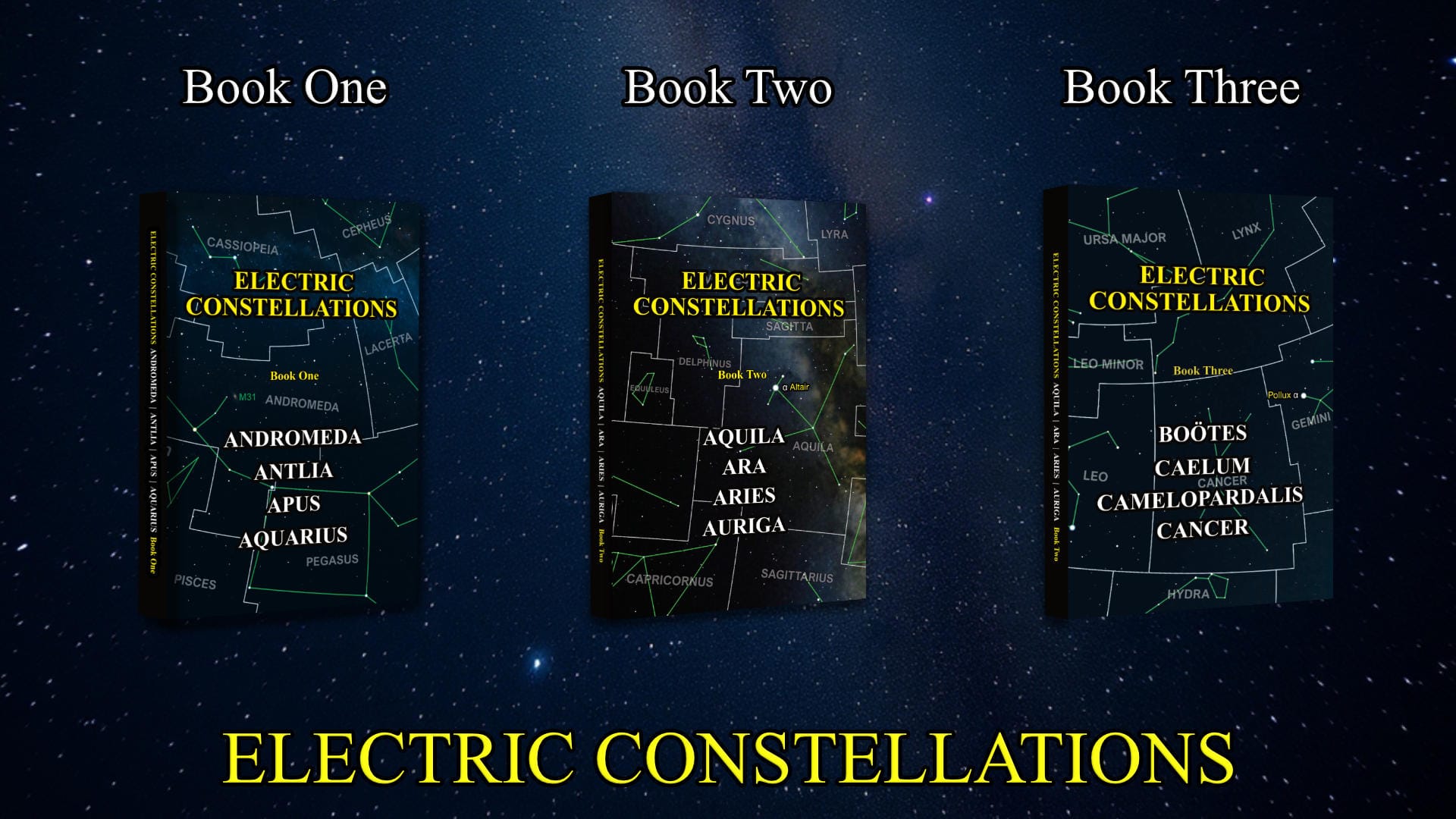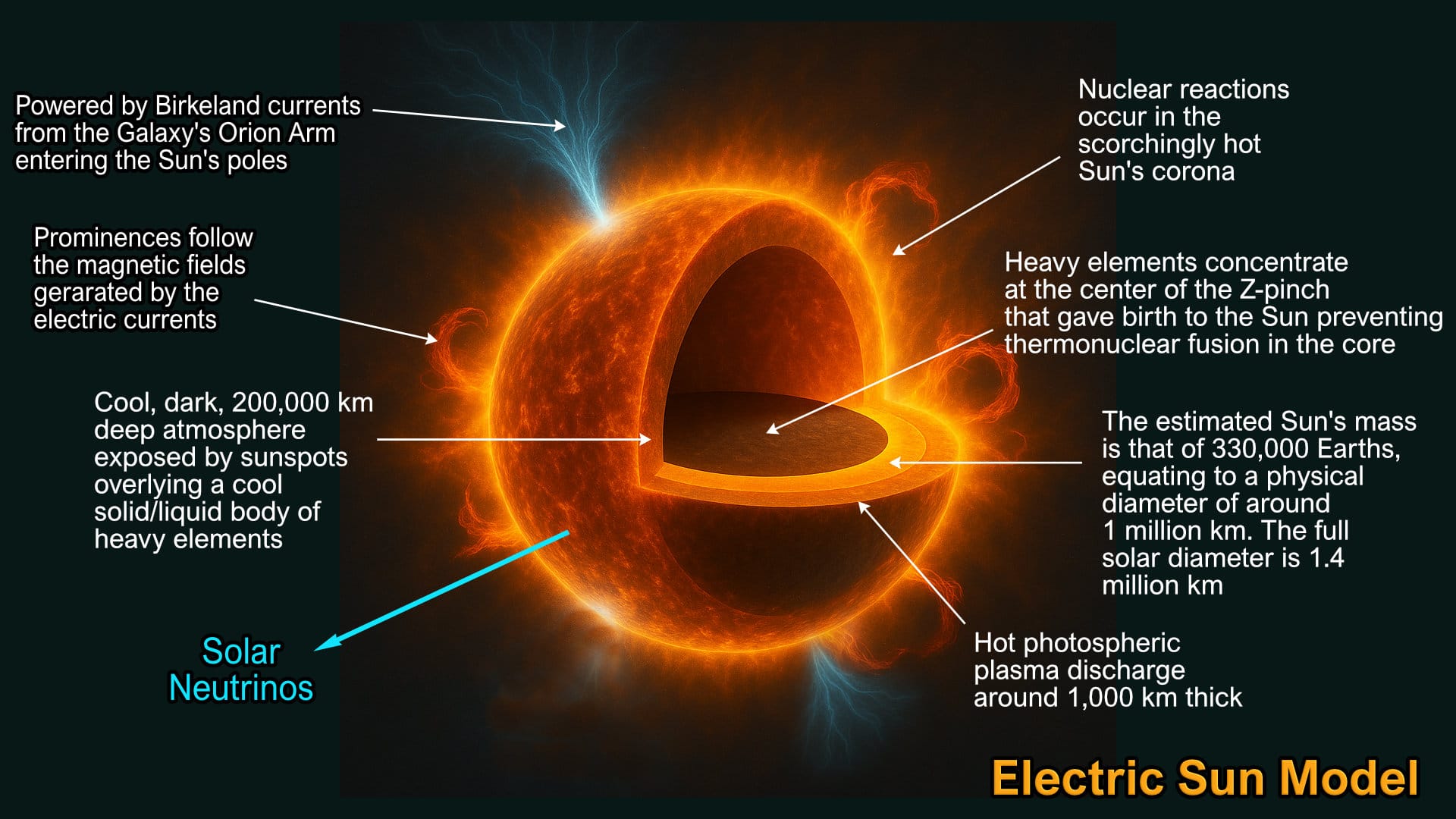Electric Sun Model Explanation & Insights
Electric Sun Model Explanation & Insights
The Electric Sun Model proposes that the Sun is powered by external electric currents rather than nuclear fusion reactions in its core, which explains several solar mysteries that mainstream models struggle to account for. For instance, if nuclear fusion reactions occur deep inside our abiding star, why then do breaks in its photospheric surface appear dark? Indeed, if nuclear fusion at millions of degrees Kelvin occurs inside the Sun, wouldn’t the breaks in its photosphere (sunspots) shine brilliantly?

Notice the filamentous nature of the Sun’s photosphere in the image here. If anything, they are huge tornadic structures connected with the Sun’s dark interior. The image here is a bit of a giveaway.
The Electric Universe theory suggests the Sun functions as an anode in a galactic circuit, with electrical current flowing along the Galaxy’s Orion arm and into the Sun’s poles.
The unexplained coronal heating problem (why the Sun’s atmosphere is millions of degrees hotter than its 5,800 K surface) aligns naturally with electric discharge phenomena.
NASA’s Ulysses mission detected strong electrical currents around the Sun, providing intriguing evidence that proponents cite to support electrical models. More about this mission here.
The SAFIRE Project is conducting laboratory experiments to test aspects of the Electric Sun hypothesis, potentially bridging theoretical ideas with empirical evidence.
What if everything we thought we knew about how the Sun works is incomplete? While mainstream astronomy indoctrinates the ignorant with musings that the Sun is powered by nuclear fusion in its core, an alternative model proposes something radically different: that our abiding star is fundamentally an electrical phenomenon, drawing its energy from galactic electric currents. This concept forms the heart of the Electric Sun Model, a theory that challenges conventional solar physics in fascinating ways.
The Electric Sun Model is part of the broader Electric Universe theory proposed by researchers outside mainstream astronomy. Advocates like the late Wallace Thornhill and Prof. Donald Scott suggest that electrical forces—rather than gravity alone—play a dominant role in cosmic structures and stellar functions. While controversial among conventional astrophysicists, the Electric Sun Model offers intriguing explanations for several solar mysteries that standard models struggle to address.
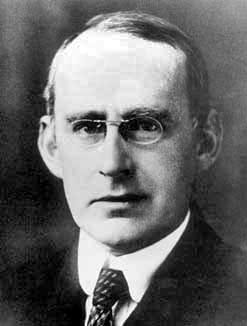
Arthur Eddington
The Electric Sun Model represents a fundamental reimagining of stellar physics. Instead of viewing the Sun as a self-contained nuclear fusion reactor, as proposed without evidence by the British mathematical physicist Arthur Eddington (1882-1944) a whole century ago in 1926.
He wrote the book ‘The Internal Constitution of the Stars’ (1926). Eddington's theoretical work in stellar physics seemed to solve the puzzles of powering the Sun for billions of years and how the Sun could remain so huge against the tendency to collapse due to its own strong gravity.
In that publication, Eddington wrote: “It is not enough to provide for the external radiation of the star. We must provide for the maintenance of the high internal temperature, without which the star would collapse.”
Quite. And ever since then, physicists have been trying to mimic nuclear fusion here on Earth. The Electric Sun Model portrays our star as an electrically powered anode in a vast galactic circuit. This model proposes that electric currents flow into the Sun from the surrounding galaxy, creating the phenomena we observe as solar activity. Whether you’re a curious amateur astronomer or a physics enthusiast questioning standard models, understanding this alternative perspective offers a thought-provoking journey into how celestial bodies might function in an electrically connected cosmos.
Why the Sun is an Electric Powerhouse
Imagine the Sun not as an isolated ball of gas undergoing nuclear fusion as mainstream astronomers believe, but as a cosmic lightbulb connected to the galactic and intergalactic power grid. The Electric Sun Model suggests exactly this—that our star, and all others, operates primarily as a focal point for enormous electric currents flowing through space. According to proponents like Ralph Juergens, who first developed this concept in the 1970s, the Sun functions as an anode (positive terminal) in a vast electrical circuit that spans the Galaxy. See here.
These cosmic currents, they argue, provide the primary energy that powers the Sun’s radiance, with nuclear reactions occurring as a secondary effect in the corona and photosphere rather than the primary energy source.
Electric Universe theorists point to numerous solar phenomena that they believe demonstrate electrical properties. The filamentary structure of the Sun’s surface, the behavior of Sunspots, as mentioned above, the explosive nature of solar flares, and even the acceleration of the charged particles away from the Sun, erroneously dubbed the “solar wind,” all display characteristics that, in their view, better match electrical discharge patterns than thermal or gravitational processes.
Perhaps most compellingly, they argue that the Sun’s activity correlates with its electrical interaction with the broader Galactic environment, suggesting that solar cycles might be linked to variations in these cosmic currents.
The Electric Sun hypothesis presents a radical alternative to standard solar models that have dominated astrophysics for one hundred years. While conventional models place nuclear fusion at the Sun’s core as the primary power source, electrical theorists suggest this is putting the cart before the horse—that external electrical inputs trigger and maintain solar processes. This fundamental shift in perspective challenges stubborn scientists to reconsider basic assumptions about stellar physics and energy generation in space.
Unsolved Solar Mysteries That Challenge Standard Models
Despite centuries of solar observation and decades of space-based research, our star continues to baffle scientists in numerous ways. These persistent mysteries provide the context in which alternative models like the Electric Sun Model gain traction. By examining these unsolved puzzles, we can better understand why some researchers look beyond the standard model for explanations.
The Missing Neutrino Problem

For decades, one of astrophysics’ most perplexing mysteries was the solar neutrino problem—scientists detected only about one-third of the neutrinos that standard solar models predicted should be emanating from the Sun. This discrepancy initially raised serious questions about our understanding of solar fusion processes.
While mainstream science eventually resolved this through the sticking plaster discovery of neutrino oscillation explanation (the ability of neutrinos to change “flavor” as they travel), Electric Sun proponents suggest an alternative explanation: if the Sun is not primarily powered by core fusion but by external electrical processes, we would naturally expect fewer neutrinos than predicted by standard models.
Corona Temperature Paradox
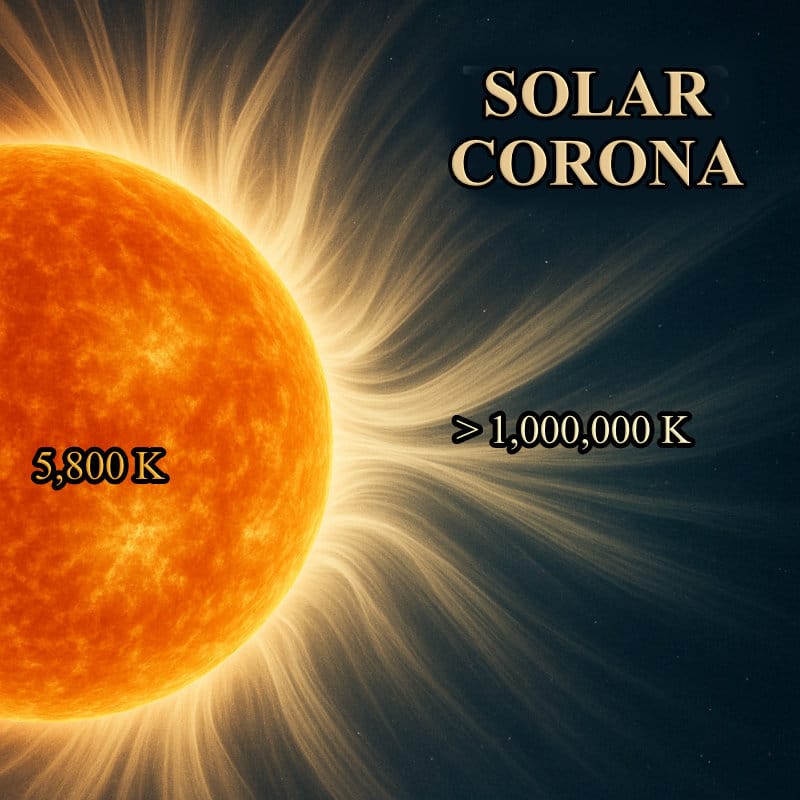
The most compelling mystery supporting electrical interpretations is the coronal heating problem. The Sun’s visible surface (photosphere) maintains a temperature of about 5,800 K, yet mysteriously, the corona—its outer atmosphere—soars to temperatures exceeding 1 million K. This temperature inversion defies conventional thermodynamics, where heat typically flows from hotter to cooler regions.
Standard models strain to explain how energy bypasses the cooler chromosphere to heat the corona.
Impossible magnetic reconnection theories require specific conditions that may not be sufficient for the observed heating.
The Electric Sun Model suggests the corona is heated by electric currents, similar to how a neon light works.
Electrical discharge naturally produces extremely high temperatures in its outer regions.
This temperature paradox remains one of solar physics’ greatest challenges, with numerous competing theories in mainstream science attempting to resolve it. Electric Sun proponents argue their model elegantly explains this phenomenon as a natural consequence of electric discharge processes, where the highest temperatures occur in the outer regions of the discharge rather than at the source.
Unexplained Solar Phenomena

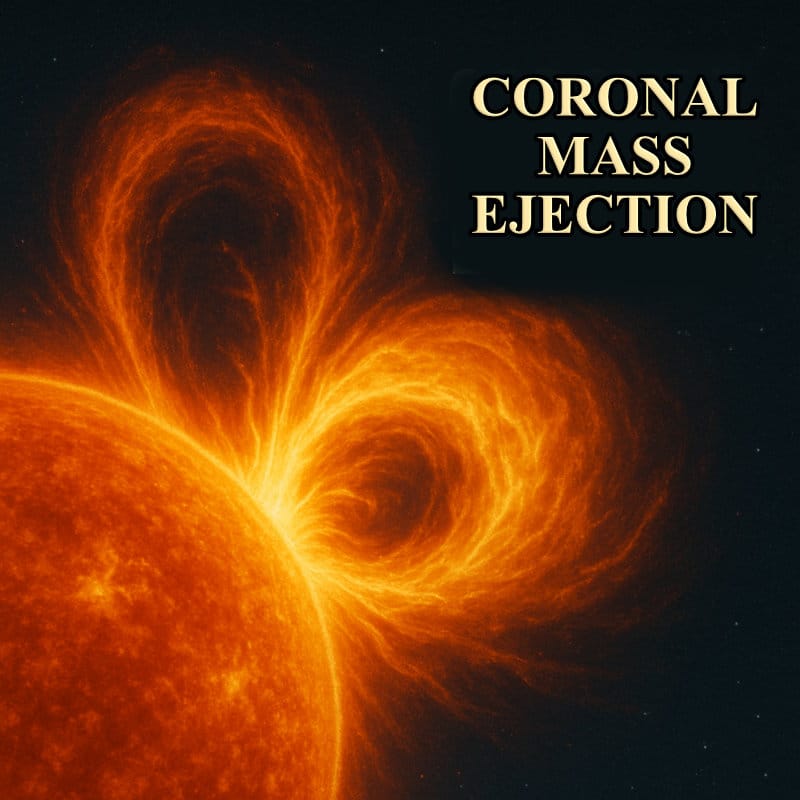
The Sun exhibits numerous behaviors that continue to challenge conventional explanations. Solar flares and coronal mass ejections (CMEs) release enormous amounts of energy in ways that sometimes defy prediction.

The stream of charged particles erroneously dubbed the solar “wind” accelerates as it moves away from the Sun, contrary to what gravity-based models predict.

Sunspots display intense magnetic fields with origins not fully understood. The electric model interprets these phenomena as manifestations of cosmic electrical processes—Sunspots as areas where currents penetrate the photosphere, solar flares as enormous electrical discharges, and the solar wind acceleration as an electric field effect.
These persistent mysteries strain the standard solar model, highlighting areas where astrophysicists' understanding remains incomplete. Electric Sun theorists argue that their model provides more straightforward explanations for these phenomena, treating them as manifestations of electric currents and fields rather than strange magnetic effects secondary to imagined internal nuclear processes.
Core Principles of the Electric Sun Model
The Electric Sun Model revolves around several foundational concepts that fundamentally reframe our understanding of stellar physics. At its core lies the proposition that stars are plasma balls connected to vast cosmic electrical circuits and not isolated nuclear furnaces as suggested by Eddington a century ago. This perspective shifts our focus from internal gravitational processes to external electrical connections, potentially revolutionizing how we interpret stellar phenomena and galactic structures.
The Sun as an Anode in a Cosmic Circuit
According to Electric Sun theorists, our star functions primarily as an anode (positive electrode) in a galactic circuit. This model suggests that electrons flow toward the Sun from the surrounding space, particularly through the heliopause—the boundary where the Solar System meets interstellar space. As these electrons accelerate toward the Sun, they create an electric field that manifests as phenomena we observe. This electrical connection is not limited to our star but extends throughout the galaxy, with stars serving as nodes in a vast network of cosmic electrical pathways.
Proponents suggest that this circuit connects not just to nearby space but extends to the galactic center and beyond between galaxies. The Sun’s electrical environment is theorized to interact with the broader galactic circuit, influencing solar behavior and even explaining solar cycles as variations in this cosmic current. Rather than seeing the Sun as generating energy in isolation, this model portrays it as a concentration point for energy flowing through much larger systems—a cosmic step-down transformer in an electric Universe.
Electric Currents and Solar Energy Production
In the Electric Sun Model, the primary energy mechanism is not nuclear fusion in the core but electrical discharge in the Sun’s atmosphere. As electric currents flow through the solar plasma, they naturally create heat, light, and magnetic fields through processes similar to those we observe in laboratory plasma experiments. The tremendous energy output of the Sun comes predominantly from these cosmic currents, with any nuclear fusion occurring as a secondary effect of the electrical processes rather than the primary driver.
The model suggests that electrical discharges in the Sun’s atmosphere create the intense heat and light we observe. Similar to how a neon light glows when current passes through gas, the Sun’s photosphere and corona light up as cosmic current flows through the solar plasma. This process naturally explains the filamentary structure of solar phenomena, the formation of Sunspots, and even the acceleration of the solar wind—all as manifestations of electric currents rather than purely thermal or gravitational effects.
Ralph Juergens’ Original Hypothesis

Ralph Juergens
The foundations of the Electric Sun Model were laid in the 1970s by Ralph Juergens, an engineer who proposed that the Sun might be powered primarily by electrical processes. Inspired by plasma physicist Hannes Alfvén’s work and Immanuel Velikovsky’s controversial theories, Juergens suggested that the Sun functions as a focus for galactic electric discharge rather than a self-contained fusion reactor. He calculated that a current of approximately 4 × 1016 amperes flowing into the Sun would account for its energy output—an enormous but not implausible figure given the scale of cosmic phenomena.
Juergens’ radical hypothesis challenged the emerging consensus around nuclear fusion as the Sun’s energy source. While fusion had become the accepted explanation for stellar energy production, Juergens pointed to various observations that failed to neatly fit this model, including the coronal temperature paradox and certain aspects of solar behavior. His electrical interpretation provided alternative explanations for these anomalies, framing them as natural consequences of electric discharge phenomena rather than requiring complex secondary mechanisms to explain them within the fusion model.
How Electric Forces Shape the Sun
The Electric Sun Model posits that the structure and behavior of the Sun are primarily shaped by electromagnetic forces rather than by gravity and pressure alone. In this model, the Sun’s layered structure, from core to corona, develops naturally from the electrical interaction between the solar body and its galactic environment. The photosphere represents not simply the visible surface of a plasma ball but the region where cosmic electric currents interact most intensely with solar plasma, creating the phenomena seen as Sunlight.
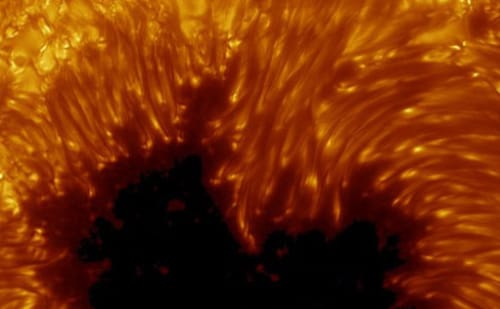
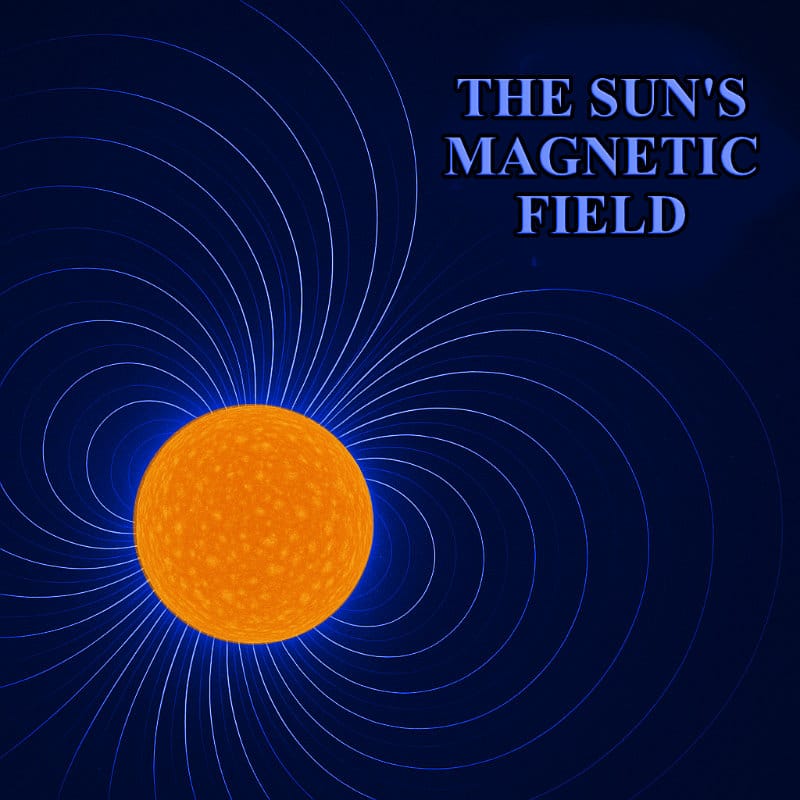
Similarly, the solar magnetic field is viewed not as a self-generated dynamo effect but as a natural consequence of the electric currents flowing through and around the Sun, following the basic principles of electromagnetism where moving charges mutually generate magnetic fields.
Evidence Supporting the Electric Sun Model
While mainstream astronomy remains skeptical of the Electric Sun Model, proponents point to various observations and measurements that they believe support an electrical interpretation of solar phenomena. These range from direct space probe measurements to detailed analyses of solar surface features that display characteristics reminiscent of electrical processes observed in laboratory settings.
Solar Surface Features as Electrical Phenomena
Electric Sun advocates highlight the filamentary nature of solar surface features as evidence of electrical processes. The Sun’s surface displays intricate thread-like structures that maintain their form despite the turbulent plasma environment—a behavior characteristic of current-carrying plasma filaments observed in laboratory experiments. These solar filaments follow paths that electric current would naturally take in a plasma environment, often forming twisted pairs or rope-like structures that mirror the behavior of Birkeland currents (field-aligned currents) observed in other cosmic contexts.
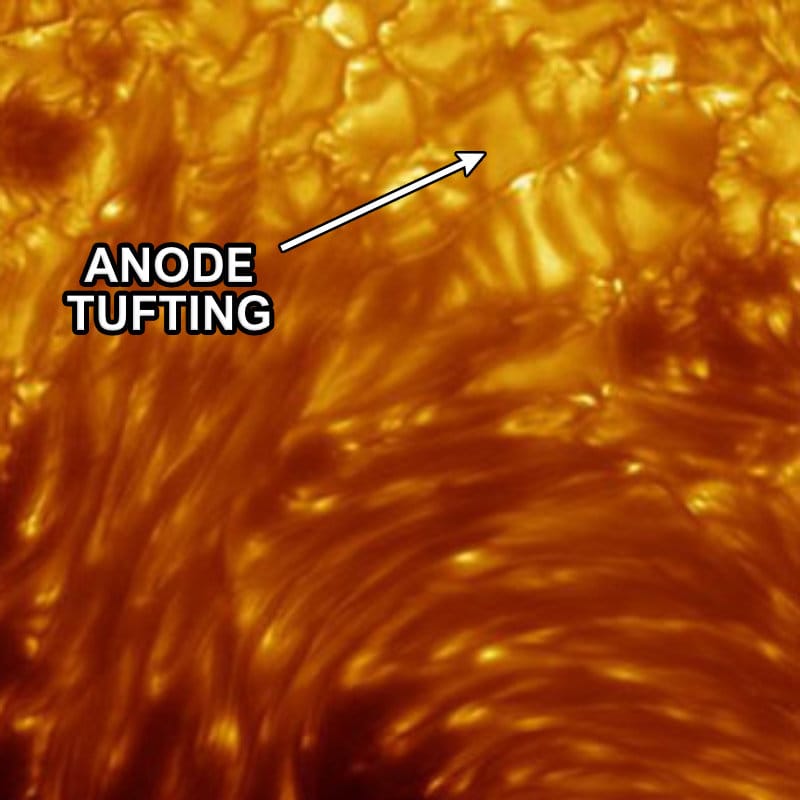
The granular structure of the photosphere, with its light centers and dark boundaries, bears striking similarities to anode tufting—a phenomenon observed in electrical discharge experiments.
When an anode surface interacts with plasma, it naturally develops a cellular pattern of bright and dark regions as current finds optimal paths through the medium. Electric Sun theorists argue that this similarity is not coincidental but reflects the fundamentally electrical nature of the Sun’s energy processes, with each granule representing a cell formed by electric currents rather than purely thermal processes.
Sunspots and Electric Discharge
Sunspots present particularly compelling evidence for electrical interpretations. These darker, cooler regions of the solar surface display intense magnetic fields and often appear in pairs with opposite magnetic polarities—exactly what would be expected if they represented entry and exit points for electric currents flowing through the solar plasma. The structure of Sunspots, with their dark central umbra and filamentary penumbra, resembles the pattern formed when an electric arc interacts with a surface, creating a central cathode spot surrounded by filamentary current channels.
The behavior of Sunspots over time also suggests electrical properties. They typically form in pairs or groups with clear magnetic connections between them, often producing solar flares and coronal mass ejections when these connections reconfigure—phenomena that mirror the explosive discharge events seen when electrical circuits suddenly change configuration. The 11-year solar cycle, with its regular variation in Sunspot numbers, likely represents fluctuations in the cosmic current powering the Sun rather than an internal magnetic dynamo process that remains theoretically challenging to fully explain in conventional models.
The Ulysses Mission Findings
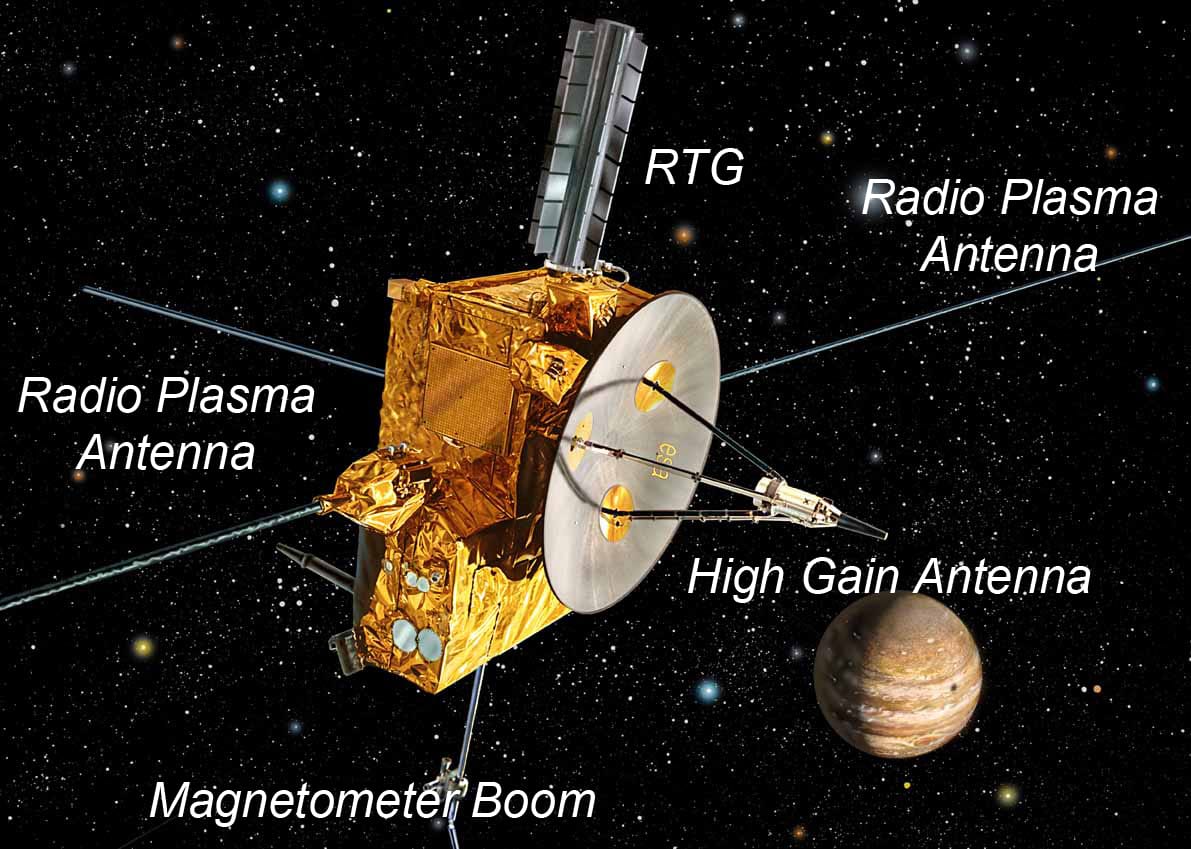
The Ulysses spacecraft, a joint NASA-ESA mission that studied the Sun’s poles between 1990 and 2009, provided data that Electric Sun proponents consider significant support for their model. Ulysses detected strong electrical currents flowing in the Sun’s polar regions—precisely where the Electric Sun Model predicts cosmic currents would enter the solar system. These measurements revealed complex magnetic field structures around the Sun’s poles that aligned with predictions of the electrical model, suggesting organized current flows rather than chaotic field patterns.
Perhaps most significantly, Ulysses observed that the solar “wind” accelerates as it moves away from the Sun—a finding difficult to explain in purely gravitational models where the wind should decelerate as it works against solar gravity. In the Electric Sun Model, this acceleration occurs naturally as charged particles respond to the electric field extending from the Sun into space. The mission also detected unexpected variations in solar wind properties that correlated with changes in solar activity, potentially indicating connections between external electrical conditions and internal solar processes that conventional models don’t fully address.
Birkeland Currents in Space
Named after Norwegian physicist Kristian Birkeland, who first proposed their existence in the early 20th century, Birkeland currents are electric currents that flow in space. Electric Sun proponents point to the discovery of these currents throughout the cosmos as supporting evidence for their model. Space probes have detected these currents flowing between planets and their moons, within planetary magnetospheres, and potentially on larger scales between stars and their galactic environments.
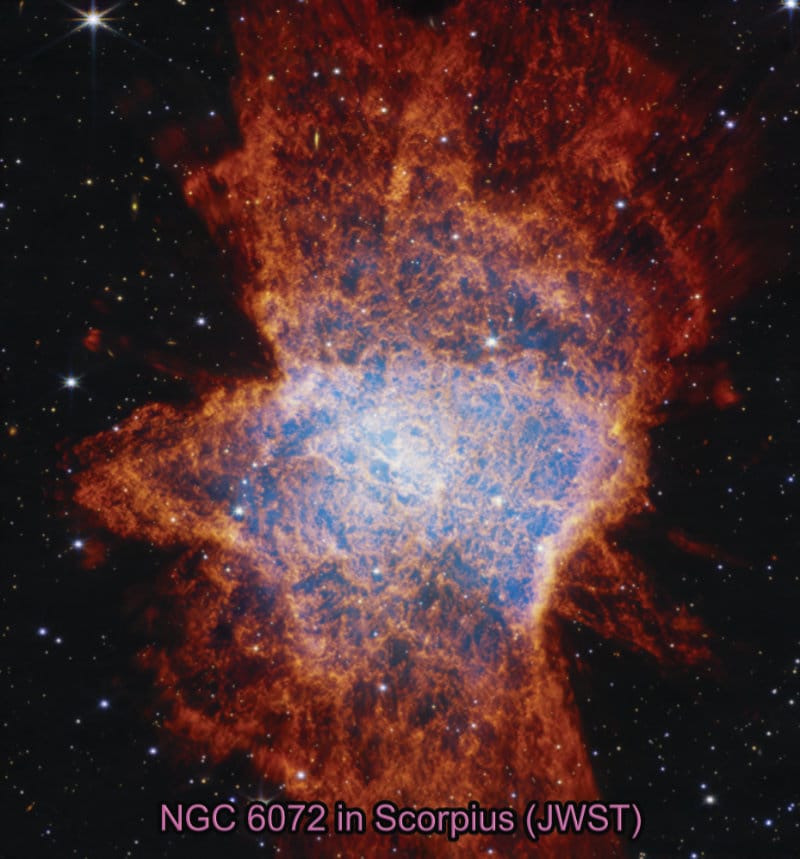
The filamentary structures observed in nebulae, galactic arms, and even between galaxy clusters bear striking resemblances to plasma discharge patterns created in laboratory experiments. These cosmic filaments conduct electricity over vast distances, potentially creating the galactic circuits that the Electric Sun Model proposes power our star. The widespread presence of these currents suggests that space is not the electrically neutral environment assumed in conventional cosmology but is crisscrossed by electric currents that could connect stars to their galactic environments in precisely the way the Electric Sun Model describes.
How an Electric Sun Would Actually Work
According to Electric Sun theorists, our star operates as a positively charged anode in a vast cosmic circuit. The Sun’s electrical potential attracts electrons from the surrounding galactic environment, creating an electric field that extends throughout the solar system. As these electrons accelerate toward the Sun, they create what we observe as the solar wind and other phenomena. This ongoing electrical interaction powers the Sun’s radiance and shapes its behavior in ways that conventional models attribute to internal nuclear processes.
Powering the Sun Through Cosmic Electricity
In the Electric Sun Model, the primary energy driving solar phenomena comes from galactic electric currents rather than core fusion. These currents come from the Orion arm of the Milky Way Galaxy and flow into the Sun primarily at its poles, following the magnetic field lines that connect our star to the broader galactic environment. As these currents interact with the solar plasma, they naturally generate heat, light, and the intense magnetic fields we observe through processes similar to those seen in plasma laboratories and high-energy electrical discharges.
The model proposes that the Sun essentially functions as a cosmic focus point for electrical energy flowing through the galaxy. Just as a transformer in an electrical grid concentrates and transforms current, the Sun serves as a node in the galactic circuit where energy concentrates and transforms. This process naturally creates the tremendous heat and light we observe without requiring the extreme core conditions and complex energy transport mechanisms of the standard solar model.
The Role of Plasma in Solar Activity
Plasma—ionized gas that conducts electricity—plays a central role in the Electric Sun Model. Unlike in conventional models, where plasma is treated primarily as a hot gas governed by fluid dynamics, the electrical model emphasizes plasma’s electromagnetic properties. The behavior of solar plasma, from the photosphere to the corona, is interpreted as responding primarily to electric and magnetic forces rather than purely thermal or gravitational influences.
This perspective draws heavily on laboratory plasma physics, where similar structures and behaviors can be created and studied. The filamentary nature of solar prominences, the cellular structure of the photosphere, and the acceleration of the solar wind all mirror behaviors observed in laboratory plasma experiments where electric currents play the dominant role. By applying established plasma physics principles to solar observations, Electric Sun proponents argue they can explain solar phenomena more directly than conventional models that often require additional mechanisms to account for observed behaviors.
Alternative to Core Nuclear Fusion
While the standard model places nuclear fusion at the Sun’s core as the primary energy source, the Electric Sun Model suggests a fundamentally different energy mechanism. Rather than energy generation occurring deep within the Sun and then being transported outward, the electrical model proposes that energy is input directly to the Sun’s outer layers through cosmic electric currents. Any nuclear fusion occurs as a secondary effect, primarily in the Sun’s atmosphere rather than its core, triggered by the intense electrical activity rather than extreme gravitational pressure.
This doesn’t mean fusion doesn’t happen—Electric Sun proponents acknowledge that nuclear reactions occur in solar flares and the blisteringly hot corona, and potentially in other regions where electrical discharges create the necessary conditions. However, they view these reactions as consequences of the Sun’s electrical nature rather than its primary power source. This perspective explains why fusion reactions can occur in the relatively low-density solar atmosphere during flare events, something difficult to account for in purely thermal models.
Comparing Standard and Electric Sun Models
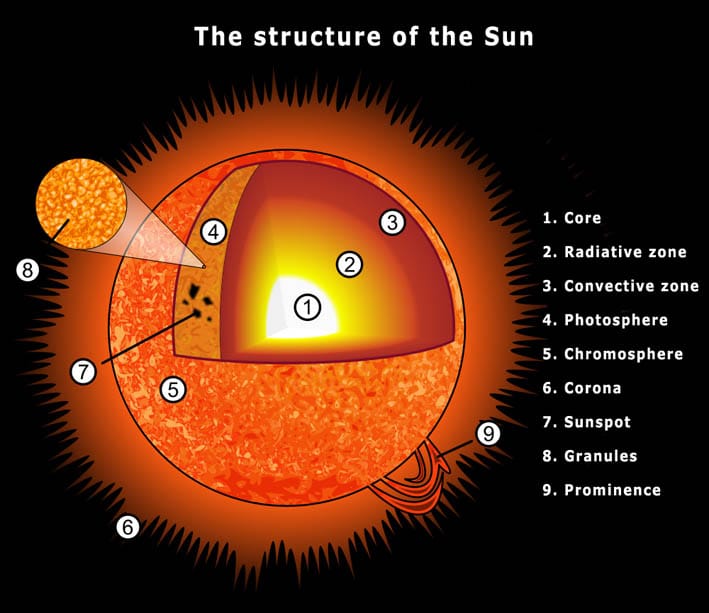
Both the standard solar model and the Electric Sun Model attempt to explain the same observations, but from fundamentally different starting assumptions. The standard model views the Sun as a self-contained fusion reactor powered by gravitational confinement, while the Electric Sun Model sees it as an electrically powered node in a galactic circuit. These different frameworks lead to contrasting interpretations of solar phenomena and different predictions about what future observations should reveal.
Predictions and Explanations
The standard solar model predicts many aspects of solar behavior, including its overall energy output and internal structure as revealed by helioseismology. It provides a coherent framework for stellar 'evolution' that aligns with mainstream understanding of nuclear physics. However, it struggles with certain observations, including the coronal heating problem, aspects of solar wind acceleration, and the complex behavior of solar magnetic fields.
The Electric Sun Model offers alternative explanations for these challenging observations. It naturally accounts for the high coronal temperature as an electrical discharge effect, explains solar wind acceleration as an electric field phenomenon, and interprets magnetic field behaviors as direct consequences of electric currents rather than a complex internal dynamo. It also accounts for the colors of stars. However, critics argue it lacks the mathematical rigor and predictive precision of the standard model, and some of its propositions challenge established principles in physics.
Strengths of Each Model
The standard solar model rests on physics principles and has been refined over decades with sticking plaster hypotheses to match observations. It explains the Sun’s overall energy output, spectral characteristics, and many aspects of its internal structure. Its integration with stellar evolution theory provides a comprehensive framework for understanding not just our Sun but stars throughout the Universe.
The Electric Sun Model’s strength lies in its straightforward explanations for phenomena that require complex secondary mechanisms in the standard model. The coronal heating problem, solar wind acceleration, and the filamentary nature of solar features naturally emerge from basic principles of plasma electrodynamics. The model also potentially connects solar behavior to broader galactic processes in ways that the more isolated standard model does not address. This holistic perspective offers intriguing possibilities for understanding cosmic connections that might otherwise remain unexplored.
The SAFIRE Project: Testing the Electric Sun Model
Moving beyond theoretical debate, the SAFIRE (Stellar Atmospheric Function in Regulation Experiment) Project represents an attempt to experimentally test aspects of the Electric Sun hypothesis. This privately funded research initiative has constructed a laboratory device designed to replicate the electric conditions that Electric Sun proponents believe exist at the solar surface. By creating a high-energy plasma environment around a positively charged sphere, the project aims to determine whether electrical processes can produce phenomena similar to those observed on the Sun. For more insights into the Electric Sun Model, visit Electric Universe Info.
Experimental Setup and Goals
The SAFIRE experiment centers around a specially designed vacuum chamber containing a spherical anode surrounded by plasma. By applying precise electrical potentials and carefully controlling the plasma environment, researchers attempt to create conditions analogous to those proposed in the Electric Sun Model. The experiment measures numerous parameters, including temperature gradients, spectral emissions, magnetic field formations, and the behavior of various elements introduced into the plasma.
The primary goal is to determine whether electrical processes alone can generate the phenomena observed on the Sun without requiring the extreme temperatures and pressures proposed in the standard fusion model. Secondary objectives include studying transmutation elements within the plasma environment, energy production efficiencies, and the formation of structures similar to those observed in the solar atmosphere. By bringing theoretical propositions into the laboratory, SAFIRE aims to bridge the gap between speculation and empirical science.
Key Findings So Far
The SAFIRE Project completed its original mandate to test the Electric Sun Model. The decision was then made to take all the discoveries and employ them in producing a commercial plasma reactor that does not generate radioactive waste. The most recent discoveries suggest the SAFIRE reactor will be able to neutralize radioactive waste while simultaneously producing energy. That's great news.
The new SAFIRE PROJECT, now a commercial enterprise, will be headed by Aureon Energy Ltd.
Researchers reported several intriguing results, such as observing phenomena reminiscent of solar features, including double-layer formations similar to those that might explain the sharp temperature gradient between the photosphere and corona. The experiment has produced spectral signatures and temperature patterns that align with predictions of the Electric Sun Model.
SAFIRE researchers found evidence of low-energy nuclear reactions occurring in their plasma environment—processes that would not be predicted by conventional nuclear physics but might support aspects of the Electric Sun Model. This finding highlights the potential for experimental approaches to test alternative models that have traditionally been evaluated primarily through astronomical observation.
The SAFIRE III ETR Thorium-fueled power cell is the heart of the Aureon Energy Micro-reactor. The SAFIRE III power cell is the product of 15 years of elemental transmutation research and a proven track record with validated 3rd party results. Interesting times are coming.
Why the Electric Sun Model Matters for Science
The Electric Sun Model serves an important function in scientific progress. It challenges researchers to critically examine assumptions, address unexplained observations, and consider alternative frameworks. The history of science demonstrates that even theories that don’t ultimately prevail often drive important discoveries and refinements by forcing mainstream models to address their weaknesses.
Potential Paradigm Shifts in Astronomy
When eventually aspects of the Electric Sun Model gain empirical support, astronomy will face a significant paradigm shift in how we understand stellar processes. Such a shift would extend beyond our Sun to all stars, transforming our interpretation of stellar formation, evolution, and behavior. Phenomena currently attributed to complex internal mechanisms will have to be reinterpreted as manifestations of cosmic electrical connections, simplifying certain explanations while complicating others.
More broadly, an electrically connected Universe would require rethinking many aspects of astrophysics, from galaxy formation to cosmic evolution. The role of dark matter and dark energy—currently invoked to explain galactic rotation and cosmic expansion—will have to be reconsidered if large-scale electrical forces play a more significant role than currently recognized. While such a dramatic paradigm shift faces enormous hurdles given the established religious-like dogma of standard models, exploring these possibilities represents the kind of boundary-pushing that has historically led to scientific breakthroughs.
Implications for Energy Research
Beyond pure astronomy, the Electric Sun Model has potential implications for energy research. If stars generate tremendous energy through electrical processes rather than solely through nuclear fusion, this will suggest alternative approaches to terrestrial energy production. The SAFIRE Project researchers now at Aureon have already suggested their findings might have applications for novel energy technologies, though the claims require rigorous verification.
The pursuit of controlled nuclear fusion for energy production has proven enormously challenging despite decades of research and billions upon billions of dollars in funding. If solar energy production involves electrical processes that trigger fusion under different conditions than currently pursued in tokamaks and other fusion devices, this will open new research directions. Such possibilities highlight how theoretical challenges to mainstream models sometimes yield practical benefits even when the alternative theory itself doesn’t gain full acceptance.
New Ways to Understand Star Formation and Evolution
The Electric Sun Model proposes fundamentally different mechanisms for star formation and evolution than the standard gravitational accretion model. Rather than stars forming through the gravitational collapse of gas clouds, the electrical perspective suggests they form at the intersections of cosmic Birkeland currents through a process called Marklund convection, where plasma is electrically pinched and separated into its constituent elements. This would explain the observed filamentary structure of star-forming regions without requiring the gravitational instabilities of standard models.
Similarly, stellar evolution in the electrical framework doesn’t follow the conventional path from main sequence to red giant to white dwarf or supernova. Instead, stars would evolve primarily based on changes in their electrical environment and the cosmic currents feeding them. This perspective offers alternative explanations for phenomena like variable stars, stellar outbursts, and even supernovae as primarily electrical rather than gravitational or nuclear events. While challenging to mainstream astronomy, these interpretations provide thought-provoking alternatives that might address current explanatory gaps.
The Electric Universe Model: Bigger Picture Beyond Our Sun
The Electric Sun Model exists within the broader context of Electric Universe theory, which proposes that electromagnetic forces play a far more significant role in cosmic structures and evolution than generally recognized in mainstream astronomy. This perspective doesn’t reject gravity but suggests that gravity is itself a dipolar electrical phenomenon. Gravity is secondary to electrical forces in shaping cosmic phenomena, from planetary surfaces to galactic structures. Understanding this broader framework helps contextualize the Electric Sun Model within a comprehensive alternative cosmology.
Electrical Forces in Cosmology
Electric Universe proponents say that electromagnetic forces—which are 1036 times stronger than gravity—naturally dominate in plasma environments that constitute 99.9% of the visible Universe. They suggest that cosmic structures from planetary nebulae to galactic spirals are shaped primarily by electrical and magnetic forces rather than solely by gravity. In this view, the filamentary structures that NASA calls “stringy things” observed throughout the cosmos at all scales reflect plasma behaviors under electrical influence rather than gravitational effects. These filamentary structures explain morphological similarities across vastly different scale sizes.
Stars as Connected Electrical Systems
Within the Electric Universe theory, stars are not isolated bodies but interconnected nodes in vast cosmic circuits that span galaxies. These connections manifest through Birkeland currents that flow along magnetic field lines, creating networks that transmit energy and potentially information throughout the cosmos. Stars with similar spectral characteristics might represent not just similar mass and composition as in standard models, but similar positions in these electrical circuits—nodes with comparable electrical environments and current flows.
This perspective suggests that phenomena like binary stars, stellar clusters, and even galactic structures result from electrical organizing principles rather than purely gravitational ones. The observed correlations between stellar properties reflect their electrical relationships rather than merely their intrinsic characteristics. This framework offers alternative interpretations for astronomical observations that sometimes challenge conventional explanations.
Lighting Up New Solar Science Frontiers
Whether one accepts the premises of the Electric Sun Model or not, its examination illuminates important questions about our star and highlights areas where current understanding remains incomplete. The ongoing dialogue between conventional and alternative models drives scientific progress, encouraging researchers to address explanatory gaps and develop more comprehensive theories.
As solar missions like Parker Solar Probe and Solar Orbiter gather unprecedented data from closer to the Sun than ever before, both standard and alternative models will face new tests that may resolve long-standing debates or raise entirely new questions about our luminous cosmic neighbor.
FAQs
If the Sun is electrically powered, where does the electricity come from?
Electric Sun proponents suggest that the electricity powering our star ultimately derives from galactic and intergalactic-scale processes. According to this model, the rotation of the galaxies generates vast electric potentials between the central regions and the outer arms. These potential differences drive currents that flow along the spiral arms and eventually connect to individual stars. The Milky Way essentially functions as a massive homopolar generator, with stars serving as focal points where these currents concentrate and interact with matter.
More specifically, the theory proposes that electrons flow toward the Sun from the surrounding galactic environment, particularly through the heliopause—the boundary where the Solar System meets interstellar space. These currents follow cosmic Birkeland currents that align with magnetic field lines already generated by electric currents, flowing primarily into the Sun’s polar regions.
While conventional astronomy hasn’t detected these proposed currents directly at the galactic scale, Electric Sun theorists point to various indirect evidence, including the filamentary structure of the interstellar medium and measurements from space probes that have detected electrical phenomena within the Solar System.
Why isn’t the Electric Sun Model more widely accepted in mainstream astronomy?
The Electric Sun Model remains outside mainstream astronomy for several interconnected reasons. First, it challenges fundamental paradigms about stellar physics that have been developed and refined over decades, supported by extensive observational evidence and sticking plaster mathematical models. Mathematics is a descriptive tool, not proof of reality. The standard nuclear fusion model seems to explain many solar observations and integrates with broader theories (not facts) of stellar evolution, nuclear physics, and cosmology—creating a kind of religious barrier for alternative theories to overcome.
Additionally, the Electric Sun hypothesis faces criticism for lacking the mathematical rigor and predictive precision of standard models. But since when was mathematics a science? You can model away with equations until the cows come home, but that is not necessarily how the Universe works. In computer modelling, if junk goes in, junk will come out.
While the Electric Sun theory offers qualitative explanations for certain phenomena, critics argue it hasn’t developed the comprehensive quantitative framework needed to make detailed predictions that could be tested through observation.
There are concerns about whether the proposed electrical mechanisms could sustain the Sun’s observed energy output over billions of years without violating principles of energy conservation or contradicting observational constraints. But no one knows for sure the ages of stars. The expansion of space is not real, and the Webb telescope shows fully-formed spiral galaxies as far as it can see. There was no Big Bang.
Also, physicists still have no real definition of mass and energy, which is embarrassing. Mass is linked to the speed of light in a vacuum and energy. It is not the amount of matter in a body. Energy, as far as physicists say, is a conserved property. That is not a definition of energy.
Scientific hurdles and dogmas, combined with the theory’s association with broader Electric Universe concepts that challenge multiple domains of mainstream physics, have limited its acceptance in conventional academic circles despite its popularity among many independent researchers and enthusiasts.
Does the Electric Sun Model completely reject nuclear fusion?
No. Contrary to some characterizations, the Electric Sun Model doesn’t reject nuclear fusion as occurring in the Sun—rather, it reframes fusion’s role and location. Most Electric Sun proponents acknowledge that nuclear fusion reactions do occur, particularly during solar flares and potentially in other regions of the solar atmosphere. However, they view these fusion processes as secondary effects triggered by electrical discharges rather than the Sun’s primary energy source.
In this model, fusion happens primarily in the Sun’s outer layers, where electrical discharge phenomena create the necessary conditions, rather than in the core, where extreme gravitational pressure supposedly creates fusion-enabling conditions. This perspective explains observations of fusion products during solar flares without requiring the complex energy transport mechanisms of the standard model to explain how energy generated in the core reaches the surface.
It also addresses why fusion appears to occur in the relatively low-density solar atmosphere during energetic events—a phenomenon difficult to explain in purely gravitational/thermal models but natural in an electrical framework where discharges can locally create extreme conditions capable of triggering nuclear reactions.
What observations would definitively prove or disprove the Electric Sun Model?
Several types of observations could significantly strengthen or weaken the Electric Sun Model. Detection of steady electron flows from the heliosphere toward the Sun, particularly concentrated at the solar poles as the model predicts, would provide strong supporting evidence. Similarly, finding clear evidence of the proposed galactic-scale current paths connecting to our star would substantially validate the theory’s foundational premise. Conversely, definitive measurements showing the absence of such currents would seriously undermine the electrical model.
The ongoing Parker Solar Probe mission, which is venturing closer to the Sun than any previous spacecraft, may provide crucial data. If it detects electric fields and current patterns aligned with the Electric Sun Model’s predictions, this would strengthen the theory. Unfortunately, the Probe can’t get close enough to the Sun to take the necessary measurements without being destroyed.
Alternatively, if its measurements align precisely with standard model predictions while contradicting electrical interpretations, this would challenge the Electric Sun hypothesis. Laboratory experiments like the SAFIRE Project may also provide relevant evidence if they can reliably reproduce solar phenomena through electrical processes alone, or conversely, demonstrate that such processes cannot account for observed solar behaviors without invoking the conditions described in the standard model.
Ultimately, scientific theories gain acceptance through their ability to explain observations more comprehensively and make more accurate predictions than competing models. Whether the Electric Sun Model will eventually demonstrate these qualities sufficiently to gain wider acceptance remains an open question that only continued research—both observational and experimental—can answer.
The Electric Sun Model represents one of the most comprehensive alternative frameworks for understanding our star’s behavior. While it remains controversial in mainstream astronomy, it continues to inspire research and discussion that contribute to our evolving understanding of solar physics. By challenging conventional wisdom and offering fresh perspectives on long-standing solar mysteries, it exemplifies the important role that alternative theories play in the scientific process—pushing researchers to question assumptions, address explanatory gaps, and seek ever more comprehensive understandings of the cosmos.
As we continue to explore our nearest star with increasingly sophisticated instruments and analytical techniques, the dialogue between standard and alternative models will undoubtedly yield new insights—regardless of which theoretical framework ultimately proves most accurate. The Electric Sun Model, whether it eventually gains wider acceptance or remains primarily of historical interest—which is now most unlikely due to the awakening of many scientists—highlights the ongoing nature of scientific inquiry and the excitement of cosmic exploration in an era when our understanding of the Universe continues to evolve.
Challenge the standard model—explore the cosmos through the Electric Universe Theory. These Electric Constellations books contain full-color, data-rich investigations of four constellations each. They're not a beginner's star guide—they're a serious work for independent thinkers, astronomers, and scientifically literate readers seeking to understand the Universe beyond conventional gravity-based interpretations.
Each constellation is examined in detail, with attention to its Bayer-designated stars, mythological origins, meteor showers, and bordering constellations. In-depth profiles of deep-sky objects—including galaxies, planetary nebulae, and star clusters—are paired with high-resolution imagery from the Webb and Hubble space telescopes, delivering both scientific clarity and visual impact.
Central to this series is the Electric Universe (EU) model, which proposes that electromagnetic forces—not gravity alone—govern much of the structure and behavior of the cosmos. Rather than treating this as speculative fringe, the book frames the EU model as an evidence-based, plasma-physics-informed alternative to the standard cosmological narrative.
Inside each volume:
- Comprehensive coverage of four distinct constellations
- Analyses of deep-sky objects in the EU context
- Original commentary on plasma discharge features and Z-pinch configurations
- Mythological and historical context without romantic embellishment
Written for readers who demand more than rote repetition of gravitational dogma, Electric Constellations opens a new observational and theoretical frontier—where stars light by electrical currents, not fusion, and where structure emerges from plasma dynamics, not dark matter.
Whether you are an amateur astronomer, electrical engineer, or astrophysicist curious about alternative models, these books deliver a rigorous and visually stunning exploration of the night sky—illuminated by a very different current.
